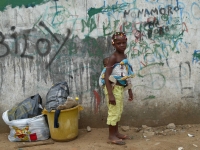Louise Redvers
LUANDA, Sep 29 2009 (IPS) – Angelina Silva doesn t remember the exact dates when her sons died. She just remembers their ages.

Many Angolan children don t reach their fifth birthday. Credit: Louise Redvers/IPS
One was one year old, the other was one year and nine months, she said. They had an illness. We think it was malaria, but we don t know for sure.
The 30-year-old, who has five other children and lives in a shantytown on the outskirts of Angola s capital Luanda, is unsentimental.
Balancing her 11-month-old on her lap as she sits among litter by the roadside, selling fruit to passers-by, she said: It is normal here that children die young. Malaria is everywhere. What can you do?
Angola is ranked 16th in the world for child mortality. According to the United Nations Children s Fund (UNICEF), one in six children here die before they reach their fifth birthday the main causes of death being malaria, respiratory infections, diarrhoea and other infections.
The ranking, although dire, is at least some improvement from the 2001 count of one in four which had Angola ranked worst in the world but there is still some way to go if the country is to reach the 2015 Millennium Development Goal (MDG) of reducing child mortality by two thirds.
Related IPS Articles
Angola s high child mortality rates are a direct hangover from the country s three-decade-long civil war, which ended in 2002.
The few health services which existed for Angolans before they gained independence from Portugal in 1975 when the conflict began were soon decimated, and despite its enormous oil and diamond wealth, the country was wracked by poverty.
Millions fled the countryside, where landmines rendered agricultural land useless, and moved to Luanda, now home to an estimated seven million people. The majority lives in shantytowns, known in Angola as musseques, with little access to running water or sanitation.
No sanitation
Since the end of the war, government has undergone a programme of national reconstruction, literally rebuilding or building from scratch all public services.
In addition to building new hospitals and clinics, there has been a focus on training community health workers to promote basic household health, such as hand-washing, water treatment and sleeping under a mosquito net.
New statistics from UNICEF, Angola s Ministry of Health and the World Bank are due to be published jointly later this year and will be the litmus test to see if government spending has been making a difference.
It will also help government hone in on the worst problem areas and target its spending.
Koen Vanormelingen, UNICEF representative in Angola, believes there has been tremendous progress: The government is really committed, and it is putting its money where its mouth is. There is of course a time laps between the moment interventions are implemented and when you see the results in terms of lower mortality.
We are strong believers that Angola will be able to meet their MDGs for reducing child mortality, he said optimistically.
The everyday reality of poverty in Angola s musseques, where children play among piles of litter and stagnant water breeds diseases, seems a long way off Vanormelingen s colourful statistical bulletins, however.
Acknowledging this, he said: There is so much to be done at the same time that it gives the impression of anarchy and inefficiencies, but I do believe there is a sense of strategy and direction.
Human capacity, he said, is Angola s biggest challenge. He cited a visit to a rural municipality in Huila province where a new hospital has just opened, requiring a staff of 250.
In this municipality, the total head count for health staff is 195, so how can you staff that hospital overnight? These things take time, Vanormelingen explained.
Long wait
In the 2008 African Report on Child Wellbeing, Angola was rated 35th out of 52 countries in the continent for child-friendliness and 45th out of 52 for provision of basic services, such as health and education.
However, in its 2009/2010 spending plan, one third of the $33 billion dollar national budget will be allocated to social programmes, including health and education.
According to the World Bank, Angola s public expenditure on health is about $70 per capita, significantly higher than in most African countries, with Tanzania for example, spending just $10 per capita.
Because it takes time for investment to trickle down, a question mark remains over how much of this money is actually reaches the intended beneficiaries. Until then, most Angolans struggle on.
Outside one of Luanda s maternity hospitals, women huddle on the crumbling pavement. Not allowed into the hospital to see their sick children and grandchildren because of overcrowding, they wait outside for news, for days, sometimes weeks, putting their own health at risk while they sit among dirt and mosquitoes.
Adelina Job is on her seventh day of sleeping in the street. My grandchild is inside with my daughter, she said. I have to stay here because they need me to take them food as there is none inside. Also, they come out to tell me what medicines I need to buy from the pharmacy, because often they run out at the hospital.
The hunched 50-year-old, now mother to two daughters after losing five sons in the civil war, says she doesn t know what is wrong with her one-month-old grandson or if he is likely to survive. By the time this article is published, he may have become another statistic.